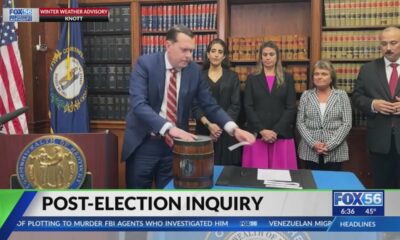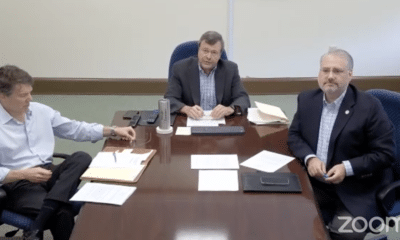News from the South - North Carolina News Feed
Familiar Berger, up-and-comer Hall to lead chambers | North Carolina
SUMMARY: Republicans have selected their executive branch leadership for the upcoming term. Senate President Pro Tempore Phil Berger, serving since 2010, will seek an eighth term, while 37-year-old Rep. Destin Hall will succeed Tim Moore as House Speaker. Berger and Hall represent Rockingham and Caldwell counties, respectively. The formal elections will take place in January, with Republicans holding majorities in both chambers. The leadership will work with new Governor Josh Stein, who succeeds Roy Cooper. The Council of State has a 5-5 split, with several incumbents re-elected and new officeholders, including Democrats Rachel Hunt and Jeff Jackson.
The post Familiar Berger, up-and-comer Hall to lead chambers | North Carolina appeared first on www.thecentersquare.com
News from the South - North Carolina News Feed
Lawmakers approve a bill that would strip away power from incoming democrats
SUMMARY: State lawmakers unexpectedly approved a bill that reduces the power of incoming Democratic leaders Josh Stein and Jeff Jackson, amidst criticism for its lack of public hearing. The controversial 131-page bill, presented as disaster relief, also alters voting laws, potentially affecting vote counting procedures. Democratic leaders have termed it an abuse of power, asserting it is a transparent effort by Republicans to maintain control following recent elections. Key changes include reducing the time for election workers to assess provisional ballots and shifting oversight of the state elections board from the incoming Democratic governor to a Republican auditor. Legal challenges are anticipated.
The state’s incoming Democratic governor and attorney general Jeff Jackson would lose key powers if the Republican-backed proposal becomes law.
News from the South - North Carolina News Feed
Concerns about lead in the water? Surprising ability to treat high-turbidity water? What are the plans to prevent another outage? And more… • Asheville Watchdog
Even though the City of Asheville is once again delivering potable water after Tropical Storm Helene devastated the water system Sept. 27, serious questions about the water’s safety, and the future of the water system remain.
Readers have sent dozens of questions to Asheville Watchdog, so we’ve compiled a roundup of them here, with answers from city officials. The Nov. 14 announcement that the city found detectable lead in seven schools is of particular concern, so we’ll start there.

Question: Readers have had multiple questions about the city’s announcement Nov. 14 that lead had been detected in seven schools — four in Buncombe County Schools, two in Asheville City Schools, and in one charter school. With 60 percent of Buncombe County’s housing stock dating to before 1988, when lead in pipes was banned, residents want to know: Is my water free of lead? If not, how much of a problem does it pose? And what should we do to protect ourselves?
Answer: The lead was detected after Asheville Water Resources suspended a standard treatment for lead mitigation for nearly three weeks because the city’s main reservoir’s sedimentation was so high and it has to use a bypass line to get water out. In all, water coming out of North Fork had no corrosion control chemicals in it for 19 days, with the program resuming on Oct. 30.
Corrosion control prevents lead from leaching into pipes and into tap water. The lead comes from solder used in older homes and buildings — those built in 1988 or before. It can leach into water systems when corrosion in pipes occurs, including from chlorine treatment, which is standard in municipal systems to kill contaminants.
The city has stated repeatedly that its testing has found no lead in the North Fork reservoir, Mills River treatment plant, or its distribution lines.
The city normally treats for lead prevention with zinc orthophosphate and sodium bicarbonate, minerals that coat the insides of pipes. The zinc material absorbs the lead, keeping it from reacting with the water, while the bicarbonate stabilizes the pH to slow corrosion.
Remember to flush
City officials have stressed that with proper flushing, lead leaves the pipes quickly. Assistant City Manager Ben Woody said at the Tuesday daily Helene briefing that the city initially tested 25 schools, childcare facilities and a residence, with lead detected at seven schools.
Woody said the city flushed the pipes at the seven schools for 30 seconds, and afterward six of them had no detectable lead levels, illustrating the importance of flushing pipes. One school, in South Asheville and on the Mills River water system, never lost corrosion control but still had detectable lead in water because the water had sat in pipes for so long.

“If you have water that sits in your pipes for more than four to six hours, and you live in a home built before 1988, you should be doing this (flushing) in any event,” Woody said.
The city has had a lead awareness program in place for several years.
“We’ve always said to flush your cold water lines for 30 seconds to two minutes (before) use, if the water has been setting for more than four hours,” Brenna Cook, the compliance officer for Asheville Water Resources, said at the briefing. “And this is if you’re using it for consumption. It is safe to wash your dishes, take a shower, wash your clothes in. There’s little possibility of lead exposure from those types of usage.”
You should always use cold water for cooking. Let the tap run until the water temperature changes, typically becoming slightly cooler.
Residents of homes built in 1988 or before should continue this flushing technique, as corrosion control can take 30 to 90 days to re-establish itself, Woody said. Corrosion control treatment was reestablished on Oct. 30.
Boiling does not remove lead
The city had a “boil water notice” in place until Nov. 18, and it recommended that residents use bottled water for consumption. But it also has said throughout the outage that if residents had no other option for potable water, they could boil water for at least a minute before consumption.
The Centers for Disease Control & Prevention notes that boiling water that may have lead in it will not reduce the amount of lead. Lead can cause development problems in children and is a well-known health hazard, and the CDC says there is no safe level of lead in water for children.
While the risk of exposure here was low, residents in older homes may have had exposure during the 19 days when treatment was suspended — if they were using boiled tap water for consumption.
“We are being inundated with lead test kit requests,” Cook said. “The people who need to be most concerned are people who are breastfeeding or pregnant, or people who have children in the home (under age 6), and especially homes built 1988 or before.”
Woody said the city will do another round of testing at schools at 30, 60 and 90 days. The city cannot run in-house lead testing.
“We do contract that out, and the lab that is doing that, it takes four to six weeks to get those results back,” Cook said.
You can request a lead testing kit here.
The city’s overall testing results can be found on the city’s Water Resources “Helene Response and Recovery” page, under “Post-Helene Lead and Copper Sampling Plan and Results.”
Why wasn’t lead issue disclosed earlier?
Asked why the city didn’t disclose the potential for lead exposure sooner, Woody said the city did not make an announcement about the lead until it had test results back. Initial results came in Nov. 4 and final results Nov. 8.
“Once we received detectable levels of lead through our sampling that we did at schools is when we made the decision to notify the community of the potential risk to lead exposure through their plumbing,” Woody said in an interview after Tuesday’s briefing.
Woody said plumbing varies from household to household, and “it’s just very difficult to say with certainty what 19 days of reduced corrosion control would do to anybody’s plumbing or house, because there are so many variables.”
At the briefing, Woody echoed the recommendation of the Buncombe County Health & Human Services department last week.
“If you have children under the age of six, or if you’re pregnant or nursing and you have concerns, please contact environmental health or talk to your pediatrician if you have concerns,” he said.

Question: What permanent changes or additions might be made at North Fork Reservoir to harden the facility or prevent another sustained outage? Will the city consider another bypass line in a different area? A heavier duty or totally different filtration system for higher turbidity? Does the city have a sort of “wish list” of needs moving forward that it would like to see addressed to prevent this in the future?
Answer: Woody said at the briefing the city has already begun an “after-action report” on the 54-day outage. The Sept. 27 storm washed out the two main distribution lines and a bypass line coming out of North Fork, which provides 80 percent of the city’s drinking water.
“A couple of things I can highlight right now is, yes, we are going to explore a primary water main that routes in a different direction,” Woody said. “We recognize that a key part of redundancy would be to have a water main from North Fork, number one, that doesn’t go underneath the spillway areas. And number two, as much as practical, avoids Swannanoa River Road.”
That would be expensive, Woody acknowledged, but he said it’s “absolutely something we’re going to look at and begin to initially move forward.” The city wants to ensure that water leaving North Fork is less vulnerable to storm-related damage.

Another action item is to proceed with “a permanent filtration improvement to North Fork so we don’t have to use the curtain anymore,” Woody said, referring to a curtain system the city installed in the reservoir to help still the water and promote coagulation of sediment. The storm caused severe sedimentation at North Fork that prevented water treatment for weeks.
“Another thing we’re going to explore — and this is already in our capital improvements plan — we want to make improvements to Mills River and increase the capacity and ability for that water treatment plant to provide water to the system,” Woody said. “So we want to increase our production outside of North Fork.”
North Fork typically produces about 21.5 million gallons of water a day, while the Mills River facility has been pumping out about 3 million gallons daily.

Question: It seems that the city water went from unsafe to drink and constant boil water notices to, “The water is fine to drink and perfectly safe.” How do we know it’s safe to drink? And how did the change occur so quickly?
Answer: In short, the city has been testing the water. A lot.
Woody said the city has performed over 1,000 water quality tests.
“We just did 120 last weekend,” Woody said Tuesday. “All those tests came back consistent with what our regulators require for us to deliver potable water to the community.”
That means no E. coli contamination or other harmful bacteria, and the outgoing level of turbidity is once again very low and under EPA parameters.
Woody noted that the return to potable water has been gradual. For several weeks, Asheville Water Resources has been adding treated water to the raw water coming out of the city’s main reservoir, North Fork.
“I think for a period of time now, we’ve been putting only potable water into the system, so we feel confident about the return of that treated water into our distribution system,” Woody said. “It’s just like it was pre-Helene.”
Essentially, the city had to push out all the untreated water from the city and replace it with treated water. That process is complete, and North Fork is once again producing enough water, in combination with the city’s Mills River treatment plant in northern Henderson County, to keep the system running under full pressure.

Question: Along the same lines, there’s confusion on how we went from needing a turbidity measurement of 1.5 to 2.0 Nephelometric Turbidity Units (NTUs) to be able to treat North Fork water to being able to treat much higher NTU water. On Monday, that number stood at 14.5 and it was even higher last week. Previously, Water Department spokesperson Clay Chandler said this hinged on the U.S. Army Corps of Engineers being able to employ a kind of portable system that allowed the city to run tests on higher-turbidity water. Can you explain how that process worked?
Answer: “There was a lot of uncertainty following this storm,” Woody said. “It was catastrophic in nature. It turned over our reservoir in a way that we’ve never seen before.”
So they had to approach water restoration in a way they’d never done before. The two primary transmission lines coming out of North Fork, as well as a backup line, were restored by mid-October.

But then the city had to deal with the extremely turbid North Fork reservoir, which had an initial NTU level of 79. One of the first moves the city made was to procure a pilot plant.
“That’s basically a test plant — it’s like a miniature representation of North Fork,” Woody said. “And what that allowed us to do is to begin testing the North Fork filter system to see if we, in fact, could place water into that plant that was of a greater turbidity than we thought otherwise we could do.”
Chemicals and curtains
The city also has conducted three in-reservoir treatment applications of aluminum sulfate, a coagulant, and caustic soda, which regulates the water’s pH levels to ensure optimum coagulation and sinking of clay particles. Additionally, the city installed the curtain system around the intake to still the water, promoting more coagulation of clay materials.
While turbidity remains, the density of the material is better.
“In other words, I think the clay particles did coagulate,” Woody said. “My understanding is they are lighter in nature, and so what we’ve found is that we can put that higher turbidity water into the North Fork treatment system.”
“But what we’ve also found is we have to do backwashes more frequently,” Woody continued. “So again, the system’s not running as it normally would with lower turbidity levels, but we are able to run it and manage it in a way that allows us to put water in again.”
Usually, North Fork’s pre-treatment water is very pure, with a turbidity under 1.0.
Cook, the Water Resources compliance manager, said, “In the water world, there’s all different kinds of turbidity.”
“When the lake was first turned over, there was a lot of mud, plus the light clay particles,” Cook said. The treatments did help settle out the mud, leaving finer clay particles that the city could filter.
“It depends on the type of turbidity you have, based on what you can run through a filter,” Cook said. “With our system, it being direct (filtration), you want a lighter turbidity instead of a heavier turbidity, and you want to be able to settle that out before you run it through the filter and cause problems with your filter or cause filter breakthrough.”
Woody said the city is backwashing the filters more frequently than usual to remove the material, but filtration can continue.
He also noted that the Army Corps of Engineers is continuing with its plan to set up a mobile filtration system at North Fork that is designed to handle higher turbidity water.
“We also have a degree of confidence, because we know that the Army Corps of Engineers is creating a redundancy, and they are still on schedule to have that completed in late November or early December,” Woody said.
That led to this question at the briefing…

Question: Why go ahead with the Army Corps of Engineers project if the city can now filter North Fork lake water?
Answer: “The most important thing that system does is create redundancy for our municipal water supply,” Woody said. “As everybody knows, North Fork is really the workhorse of our water system. Weather is unpredictable. If we were to have another storm one week from now, three three months from now, one year from now — whatever it is — we want to make sure that system is in place. Because what it allows us to do is filter water, to filter out the sediment in a way that we can make sure that North Fork is always operational.”
In short, it’s a “critical redundancy for our ability to provide water to our customers, and it’s just absolutely critical that we continue to make progress on finishing that improvement,” Woody said.

Question: When can city of Asheville water customers expect to begin being charged for their water?
Answer: Woody noted that water is an “enterprise fund,” meaning it pays for itself. The city recognizes that customers did not have potable water from Sept. 27 through Nov. 17 and was not sending out bills. Also, some flushing remains to be done, especially for businesses such as restaurants looking to reopen.
“Right now, what we anticipate is that beginning in December, we will start making meter reads again,” Woody said. “We’ll have more detailed information about that in the coming days, but we certainly don’t expect to begin billing and reading meters before early December at this point.”

Question: Regarding the curtains at the North Fork, will those be a permanent fixture? If so, are they susceptible to freezing other weather-related events?
Answer: The city bought the curtains and “will use those until the turbidity gets to a level that we are comfortable enough that we can remove them,” Woody said. “They won’t stay in the reservoir always and forever. So eventually they will come out.”
The city does not have concerns about weather-related damage to the curtains, he said.
Asheville Watchdog is a nonprofit news team producing stories that matter to Asheville and Buncombe County. John Boyle has been covering Asheville and surrounding communities since the 20th century. You can reach him at (828) 337-0941, or via email at jboyle@avlwatchdog.org. The Watchdog’s local reporting during this crisis is made possible by donations from the community. To show your support for this vital public service go to avlwatchdog.org/support-our-publication/.
Related
The post Concerns about lead in the water? Surprising ability to treat high-turbidity water? What are the plans to prevent another outage? And more… • Asheville Watchdog appeared first on avlwatchdog.org
News from the South - North Carolina News Feed
Moving truck overturns, blocking I-40 in Johnston County
SUMMARY: A major crash involving an overturned moving truck on I-40 near Smithfield and Highway 210 has created significant traffic backups. The incident occurred around 2 p.m., and although one westbound lane has reopened, officials expect delays to continue for at least another hour. Sky Five provided live footage of the scene, highlighting the truck’s severe damage. Both the driver and a coworker are reported to have survived, calling it a miracle. Traffic is backed up several miles in both directions, prompting advisories for drivers to consider alternate routes, such as Highway 50.
A moving truck overturned Tuesday afternoon on Interstate 40 near Smithfield, closing both westbound lanes for several hours.
-

 Our Mississippi Home6 days ago
Our Mississippi Home6 days agoCreate Art from Molten Metal: Southern Miss Sculpture to Host Annual Interactive Iron Pour
-

 Local News4 days ago
Local News4 days agoCelebrate the holidays in Ocean Springs with free, festive activities for the family
-

 News from the South - Georgia News Feed5 days ago
News from the South - Georgia News Feed5 days ago'Hunting for females' | First day of trial in Laken Riley murder reveals evidence not seen yet
-

 Our Mississippi Home6 days ago
Our Mississippi Home6 days agoTraverse Whoville in Downtown Hattiesburg December 6th for Seuss-Themed Cookies, Stories, Family Fun and a Bit of Snow Thrown in for Good Measure
-

 News from the South - Alabama News Feed6 days ago
News from the South - Alabama News Feed6 days agoLofton takes stand in murder trial, testifies he wanted to shoot restaurant manager, not kill him
-

 News from the South - Alabama News Feed5 days ago
News from the South - Alabama News Feed5 days agoFirst woman installed as commanding officer of NAS Pensacola
-

 News from the South - Texas News Feed6 days ago
News from the South - Texas News Feed6 days agoISIS-linked Houston man indicted, planned 9/11 style terrorist attack | Texas
-

 Kaiser Health News2 days ago
Kaiser Health News2 days agoA Closely Watched Trial Over Idaho’s Near-Total Abortion Ban Continues Tuesday




























